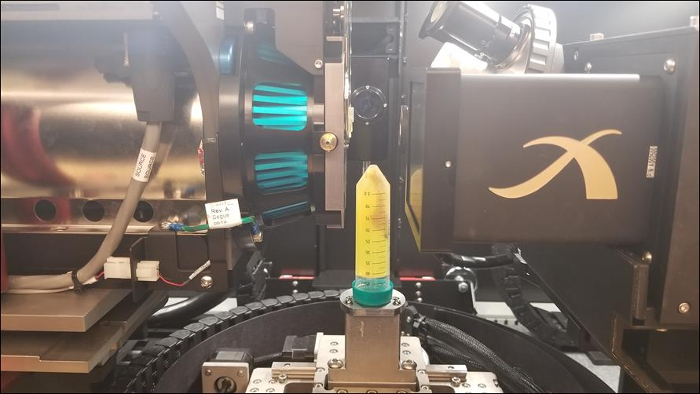Imaging micro-CT di un midollo spinale di topo
Panoramica
Fonte: Peiman Shahbeigi-Roodposhti e Sina Shahbazmohamadi, Dipartimento di Ingegneria Biomedica, Università del Connecticut, Storrs, Connecticut
È un fatto poco noto che la scoperta e l'uso (involontario) dei raggi X ha ottenuto il primo premio Nobel per la fisica. La famosa immagine a raggi X della mano della moglie del Dr. Röntgen del 1895 che ha inviato onde d'urto attraverso la comunità scientifica assomiglia alla maggior parte delle moderne immagini a raggi X medici 2D. Sebbene non sia la tecnologia più recente, l'imaging ad assorbimento di raggi X è uno strumento indispensabile e può essere trovato nei migliori laboratori di ricerca e sviluppo e università del mondo, ospedali, aeroporti, tra gli altri luoghi. Probabilmente gli usi più avanzati dell'imaging ad assorbimento dei raggi X comportano il raggiungimento di informazioni come quelle che si trovano in una radiografia medica 2D ma realizzate in 3D attraverso una tomografia computerizzata (TC o micro-CT). Prendendo una serie di proiezioni a raggi X 2D, il software avanzato è in grado di ricostruire i dati per formare un volume 3D. Le informazioni 3D possono, e molto probabilmente includeranno informazioni dall'interno dell'oggetto sondato senza dover essere tagliate. Qui si otterrà una scansione micro-CT e verranno discussi i principali fattori che influiscono sulla qualità dell'immagine.
Procedura
1. Montaggio di un campione (osso)
- Per esaminare una rete di ossa, come una colonna vertebrale, sospendere la struttura in un gel di acarosio e consentire di polimerizzare in un tubo di plastica a pareti molto sottili (Figura 2). La sottigliezza del tubo è molto importante, influenzando notevolmente il throughput del segnale e la qualità complessiva dell'immagine. Questo a sua volta influisce sulla capacità di risolvere le funzionalità. Il valore di trasmissione del tubo dovrebbe essere il più vicino possibile
Risultati
Le seguenti immagini forniscono una panoramica dei risultati che possono essere ottenuti utilizzando la micro-TC con la procedura sopra indicata. Misurazioni qualitative sull'assorbimento variabile possono essere notate direttamente sulla base di queste immagini. Dati quantitativi come la porosità del materiale, le dimensioni e la distribuzione delle caratteristiche, ecc. Richiederebbero un'ulteriore elaborazione delle immagini in un software diverso.
Log in or to access full content. Learn more about your institution’s access to JoVE content here
Applicazione e Riepilogo
Questo esperimento ha esaminato i molti fattori che dovrebbero essere considerati quando si utilizza la micro-TC, in particolare per un campione biologico. Questo progetto è stato progettato per aiutare lo sperimentatore a capire come le loro decisioni avranno un impatto sui dati che la micro-CT può fornire. Come dimostrato, ci sono molti parametri dipendenti e sensibili che dovrebbero essere considerati, tra cui: montaggio, energia a raggi X, tempo di esposizione, posizionamento della sorgente e del rilevatore, numero..
Riferimenti
- http://www.spectroscopyonline.com/tutorial-attenuation-X-rays-matter [cited 1 November 2017]
- http://hyperphysics.phy-astr.gsu.edu/hbase/quantum/xrayc.html [cited 1 November 2017]
- A.G. Rao, V.P. Deshmukh, L. L. Lavery, H. Bale, "3D investigation of the microstructural modification in hypereutetic aluminum silicon (Al-30Si) alloy." Microscopy and Analysis 2017 [cited 1 November 2017].
Vai a...
Video da questa raccolta:

Now Playing
Imaging micro-CT di un midollo spinale di topo
Biomedical Engineering
8.0K Visualizzazioni

Imaging di campioni biologici con microscopia ottica e confocale
Biomedical Engineering
35.8K Visualizzazioni

Imaging di campioni biologici con microscopio elettronico a scansione (SEM)
Biomedical Engineering
23.8K Visualizzazioni

Biodistribuzione dei vettori di nanofarmaci: applicazioni del microscopio elettronico a scansione (SEM)
Biomedical Engineering
9.3K Visualizzazioni

Imaging a ultrasuoni ad alta frequenza dell'aorta addominale
Biomedical Engineering
14.6K Visualizzazioni

Mappatura quantitativa della deformazione di un aneurisma dell'aorta addominale
Biomedical Engineering
4.6K Visualizzazioni

Tomografia fotoacustica per l'immagine di sangue e lipidi nell'aorta infrarenale
Biomedical Engineering
5.7K Visualizzazioni

Imaging a risonanza magnetica cardiaca
Biomedical Engineering
14.8K Visualizzazioni

Simulazioni fluidodinamiche computazionali del flusso sanguigno in un aneurisma cerebrale
Biomedical Engineering
11.8K Visualizzazioni

Imaging a fluorescenza nel vicino-infrarosso di aneurismi dell'aorta addominale
Biomedical Engineering
8.3K Visualizzazioni

Tecniche non invasive di misurazione della pressione sanguigna
Biomedical Engineering
11.9K Visualizzazioni

Acquisizione e analisi di un segnale ECG (elettrocardiogramma)
Biomedical Engineering
106.1K Visualizzazioni

Resistenza alla trazione dei biomateriali riassorbibili
Biomedical Engineering
7.5K Visualizzazioni

Visualizzazione della degenerazione dell'articolazione del ginocchio dopo lesione del LCA non invasiva nei ratti
Biomedical Engineering
8.2K Visualizzazioni

Imaging combinato SPECT e CT per la visualizzazione della funzionalità cardiaca
Biomedical Engineering
11.0K Visualizzazioni
